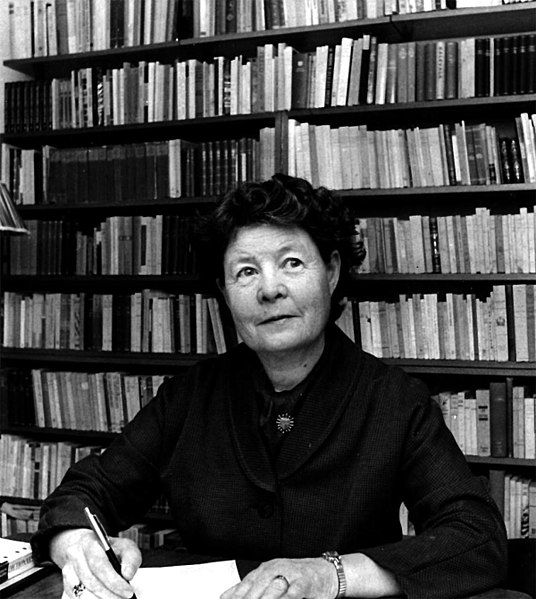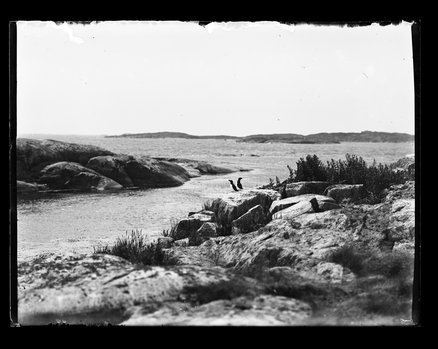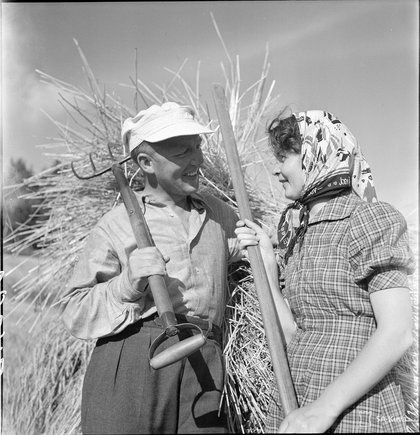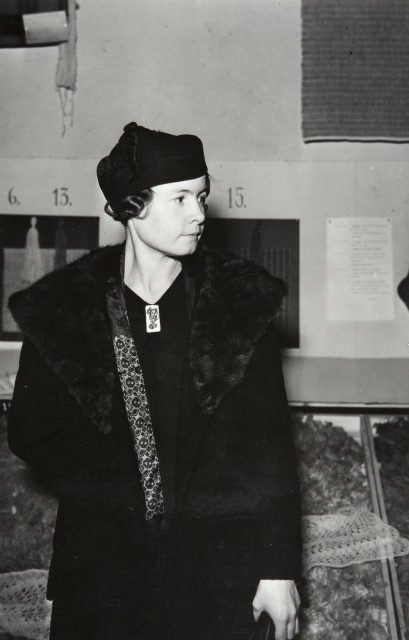Sally Salminen 1906–1976
Sally Salminen won a Finnish-Swedish literary prize for her novel 'Katrina' in the autumn of 1936 at a time when she was working as a maid in New York; it was the Great Depression and she had emigrated there six years earlier to work in wealthy households. It was a global sensation that someone like her, unknown and from the working class, could write such a good book. She was seen as a living example of the American dream and, all at once, she was able to return to the Nordics and put everything into her childhood dream: being an author. A further 16 books followed: novels, memoirs and travel stories which revolved around self-worth and social responsibility, captivity and freedom – and her debut novel has since proven to be a classic.

Early life In Åland
Sally Salminen was born to a large farming family on Vårdö, an island in the archipelago of Åland, an autonomous territory of Finland. There were 11 children and their upbringing was influenced by the reduced circumstances that followed their father’s death by drowning in 1913 and the outbreak of the First World War the following year. Salminen’s school was crucial to her life choices later on, although she only went to elementary school for a few years. It was at the encouragement of her teacher that she began to keep a diary and put her dream of being a writer into words. Even early on, Salminen knew that she did not want to live a traditional woman’s life in the village where she grew up. First and foremost, she wanted to get out into the world: she achieved this by emigrating as a worker, first to Sweden in 1924, and then to America in 1930.
Later, looking back, Salminen acknowledged that she would have liked to become an academic, but this was impossible at the time; neither being an author nor further studies were thought of as options in her home. That said, she lived in an environment where one did read a lot, and gladly. In Salminen’s work, you can see how she made use of the literature she read at an early stage of her life, such as Daniel Defoe’s Robinson Crusoe, Zacharias Topelius’ Läsning för barn (Reading for children) and Sigrid Undsets Kristin Lavransdatter (Kristin Lavransdaughter). During her time in Sweden she studied via correspondence courses in Swedish grammar, mathematics, astronomy and accounting, and in America, she attended evening classes in English. The desire for knowledge continued and she proceeded to study language, religion, philosophy, world history and literary history on her own.
 PICTURE: The coast of the Åland Islands in 1910. Photo: SLS 1555 Veterinär Bernhard Åströms glasplåtsamling. CC BY 4.0.
PICTURE: The coast of the Åland Islands in 1910. Photo: SLS 1555 Veterinär Bernhard Åströms glasplåtsamling. CC BY 4.0.
The breakthrough
When Salminen started writing seriously in New York in 1934 in the limited leisure time that she had, it was a struggle for life and death, at least that is how she portrays it in Min amerikanska saga (My American Story) (1968), the second of her four memoirs. She was in despair, not only because some employers simply looked past her as if she did not exist, but also because of the feeling of having turned 30 without having made any progress, she wrote:
| “Jag ville jag måste jag skulle spränga de bojor man redan innan jag blev född bundit mig med. Det måste gå i riktning uppåt, utåt, till frihet, till självmedvetenhet och andras aktning – eller: brista. / Jag vet att självmordstanken nu som någon gång förr inte var långt borta.” | “I wished I had blown up the shackles you bound me with before I was even born. Everything was supposed to go in the direction of upwards and outwards, to freedom, to self-awareness and to gaining other respect of others – or: burst. / Now I know that the thought of suicide was not far away.” (nordics.info translation) |
Sally Salminen had a sense of pride in common with her fictional heroine the Ostrobothnian peasant girl, Katrina, who, however, lives her life as the wife of a homeless sailor on “Torsö” (which has a close resemblance to the village Salminen came from). Katrina is taken in by sailor Johan’s beautiful words about a great country house with a beautiful garden with apples of all colours, even blue. In fact, he has no more than the simplest cottage imaginable on an empty cliff. Moving down in class gives Katrina the ability to see social injustices.
Sally Salminen was seen as Swedish Finland’s answer to Sweden’s proletarian writers. In Sweden, she was praised by Selma Lagerlöf, a literary role model and the first female member of the Swedish Academy (from 1914). And in The New York Times, the critic Stanley Young joked: “If Finland can produce another novel as good as Katrina, and will send it to America, let us send back the war debt.”
Already by 1936, Katrina had reached its 15th edition in Swedish and, within a few years, it was translated into more than 20 languages. The considerable sum of 50,000 Finnish marks, which she received for winning first prize in the Finnish-Swedish literary prize in 1936, grew rapidly and enabled her to devote time to her writing full-time.
A Nordic author
Sally Salminen has mostly been considered as a Finland-Swedish writer, but might be best described as a Nordic one. After her time in America, she lived in the Åland Islands for a few years. In the summer of 1939 she moved to Stockholm and finished writing her second novel, Den långa våren (The long spring) (1939). The stay in Sweden was interrupted by the Winter War between Finland and the Soviet Union from 1939 to 1940, when she was at the front in Northern Finland. From here, she wrote a series of reports for the Swedish weekly magazine Husmodern (Housewive) and travelled around the Nordic countries, as she, like other intellectuals, participated in The Norden Association’s lecture tour to Finland’s advantage.
PICTURE: Sally Salminen and her husband participating in the harvest in 1941 as part of volunteer work in Finland during the Continuation War. Source: Krigsmuseet. CC BY 4.0.
In 1940, Salminen married the Danish artist Johannes Dührkop, whom she met during a meeting with the Oxford Group in Finland in January 1939, where they talked about “moral re-armament” instead of military armament. Salminen lived in Denmark on a permanent basis from 1940 until her death in 1976, but they moved a lot, both within Copenhagen and around Zealand. The Salminen-Dührkop couple also liked travelling – in Europe, North Africa and the Middle East. She found motifs for her works in Åland, Sweden, Finland, Denmark, France, New York and Israel. She wrote mainly in Swedish and all her novels were published in their original language at both Schildts in Helsinki and Wahlström & Widstrand in Stockholm, the two publishers that had arranged the competition in 1936.
New themes in literature
Salminen was a modern woman, who loved her independence and saw herself as self-made – nothing had been handed to her on a plate. But, at the same time, she emphasised the responsibility of the individual and took her role as a writer and a public voice seriously. She clearly distanced herself from National Socialism early on. In a letter to the editor in the Åland newspaper in the summer of 1938, she declared that Nazism is “the narrow doctrine of self-righteousness, violence and hatred”.
Focus on voices that were normally not heard
A fundamental driving force for Salminen was to draw attention to people whose lives and experiences were otherwise invisible, and in this way she incorporated new themes into literature. With Den långa våren (The Long Spring), she raised issues that peasant women her age had to deal with, such as sexuality; if the woman had sex before marriage, she risked being labelled a whore, but on the other hand, if she remained a virgin she was declared frigid and unable to live a normal life.

The response to Sally Salminen's work - then and now
At the time, the response to Sally Salminen’s work was very diverse. After most of the “Sally Fever” from the period just after her debut novel died down, Salminen was sometimes fiercely criticised, particularly from critics in Swedish Finland, where a concise, experimental and urban modernism was valued higher than wordy, realistic prose. Nonetheless, she had many readers and also received much praise from critics. In Denmark, her new home country, she was awarded several awards, including the Principal Miss Ingrid Jespersen’s Award in 1953, and Tagea Brandt’s Travelling Scholarship in 1967. Several of Salminen’s books were first published in Danish translation, likely because the Danish critics were generally more positive than the Swedish ones.
PICTURE: Sally Salminen, probably taken at a handicraft exhibition shortly after the publication of Katrina and her breakthrough on to the literary scene. Source: Museiverket. CC BY 4.0
For many years, she was mostly remembered within literary history as a single-book writer and someone who pictured life and people’s manners. However, two decades into the 2000s, Katrina not only reaches new readers but Sally Salminen’s dramatic life and stubborn moral courage continue to attract widespread public interest. With Elin Wägner, Virginia Woolf and many others, she belongs to a tradition of women writers, who, with their work, shed light on the rough conditions for creative women. Sally Salminen was a feminist forerunner, who refused to submit to predetermined roles determined by gender or class. While from a literary and stylistic point of view her writing can be considered to display both highs and lows, it is clear that her perspectives and the topics she choose to write about remain relevant to this day.
You can read about Sally Salminen's other literary works on nordics.info by clicking here.
Further reading:
- Michel Ekman ed., Finlands svenska litteratur 1900–2012 (Finland’
's Swedish literature 1900–2012),(Helsingfors: Svenska litteratursällskapet i Finland & Stockholm: Bokförlaget Atlantis, 2014). - Roger Holmström, ’Against all odds. Sally Salminen’s Katrina and the possibilities of cultural transfer’, Battles and Borders. Perspectives on Cultural Transmission and Literature in Minor Language Areas,
ed. Petra Broomans et al, (Groningen: Barkhuis 2015), pp. 97–107. - Tuva Korsström, ’A maid’s bestselling novel’, nordicwomensliterature.net, 17 February 2012.
- Ulrika Gustafsson, Min ljusa stad. Sally Salminen, livet och litteraturen
(My bright city. Sally Salminen, life and literature), (Stockholm: Appell Förlag & Helsingfors: Svenska litteratursällskapet i Finland, 2019). - Ulrika Gustafsson, ’Stjärna, medelmåtta eller före sin tid? Om Sally Salminens återkomst’ (Star, second-rater or ahead of her time? About Sally Salminen’s return], ledare för Lysmasken, webbplats för litteraturkritik (Leader of Lysmasken, website for literary criticism), 23 December 2019.
Links:
- Podcast ’Peppe möter’, [Pepe Meets] with Peppe Öhman and Ulrika Gustafsson discussing and her authorship (in Swedish).
- ’Sally Salminen’ on nordicwomensliterature.net (in English, Danish and Swedish).
This article was submitted in Swedish and was translated in-house by nordics.info with assistance by the author.